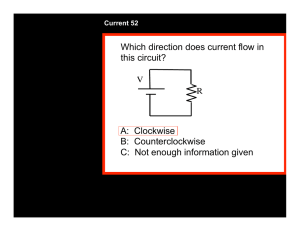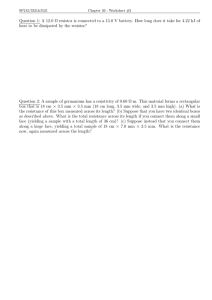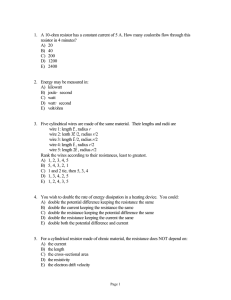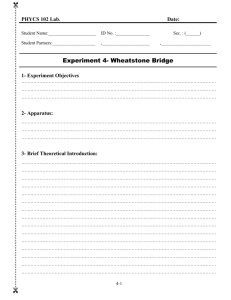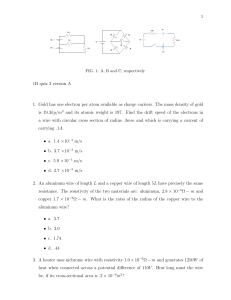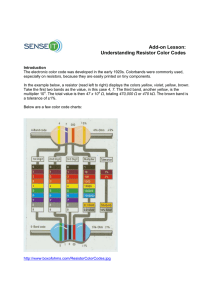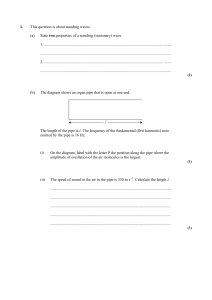16.2 Electrical Resistance
advertisement
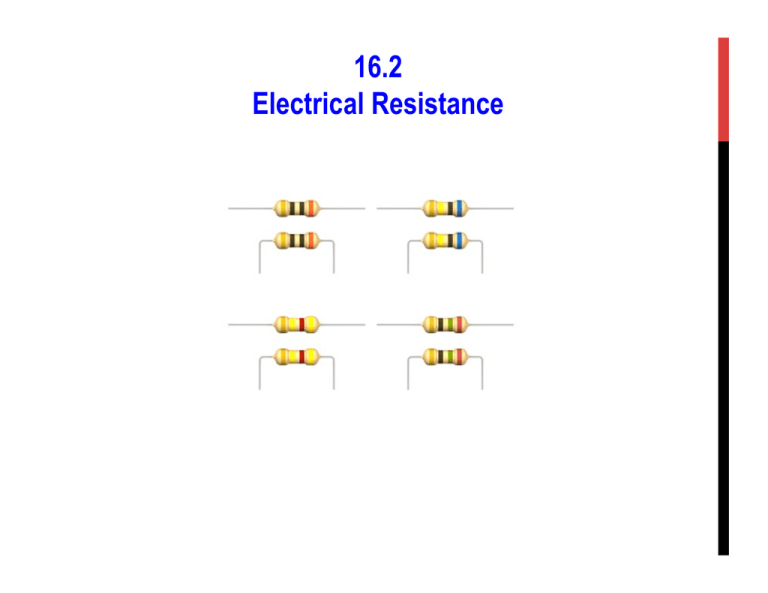
16.2 Electrical Resistance Electrical Resistance The amount of charge that flows in a circuit depends on the voltage provided by the voltage source. The current also depends on the resistance that the conductor offers to the flow of charge—the electric resistance. This is similar to the rate of water flow in a pipe, which depends on the pressure difference and on the resistance of the pipe. Electrical Resistance For a given pressure, more water passes through a large pipe than a small one. Similarly, for a given voltage, more electric current passes through a large-diameter wire than a small-diameter one. Electrical Resistance A simple hydraulic circuit is analogous to an electric circuit. Electrical Resistance The resistance of a wire depends on the conductivity of the material in the wire and on the thickness and length of the wire. • Thick wires have less resistance than thin wires. • Longer wires have more resistance than short wires. • Electric resistance also depends on temperature. For most conductors, increased temperature means increased resistance. Electrical Resistivity Materials ability to resist the flow of electric charge is known as resistivity (ρ). • Units: Ω·m (Ohm’s · meter) Electrical Resistance An objects ability to resist the flow of charge depends on both its shape and resistivity. Formula: R = ρ·L/A Units for resistance: Ω (Ohm’s) R = Resistance (Ω) L = length (m) A = area (m2) Resistance Assessment Questions Example #1 A 3.5 meter length of wire with a cross-sectional area of 3.14 x 10-6 m2 at 20° C has a resistance of 0.0625 Ω. Determine the resistivity of the wire. Resistance Assessment Questions Example #2 The electrical resistance of a metallic conductor is inversely proportional to its: a. b. c. d. Temperature Length Cross-sectional area Resistivity Resistance Assessment Questions Example #3 A copper wire is 20 m long and has a 0.254 meter diameter. Compute its resistance. Resistance Assessment Questions Example #4 A 5 Ω resistor is made from Nichrome wire 1 mm in diameter. What length of wire is required? Resistance Assessment Questions Example #5 A piece of wire 8.5 m long and 2 mm in diameter has a resistance of 3 Ω. Identify the material of the wire. Resistor Color Codes Color coding is a system of marking the resistance of a resistor. It consists of different colored bands that are used to figure out the resistance in ohms. Resistor Color Codes Resistor Color Codes • The first two or three bands correspond to a two or three-digit number. Each color corresponds to a particular digit that corresponds to a color chart. • The third or fourth band is called the multiplier band. This is the power of ten to be multiplied by your two-digit number. • The last band is called the tolerance band. It gives you an error range for the labeled resistance. Resistor Color Example A resistor color code has these color bands: Calculate its resistance and tolerance: (yellow, green, red, gold) 1. Look up the corresponding numbers for the first three colors: Yellow = 4, Green = 5, Red = 2 2. Combine the first two digits and use the multiplier: 45 × 102 = 4500 3. Find the tolerance corresponding to gold and calculate the maximum error: Gold = 5% and 0.05 (4500) = 225 So, the resistance is 4500 Ω ± 225 Ω Resistor Color Example Calculate only the resistance of each resister: #1 #1: #2: #3: #4: #2 #3 100 Ω 1,000 Ω or 1K Ω 10,000 Ω or 10K Ω 100,000 Ω or 100K Ω #4 Resistor Color Example Calculate the following for resistance and tolerance: (red, brown, green, gold) 2,100,000 Ω (2.1 MΩ) +/- 105,000 Ω (brown, black, blue, gold) 10,000,000 Ω (10 MΩ) +/- 500,000 Ω
